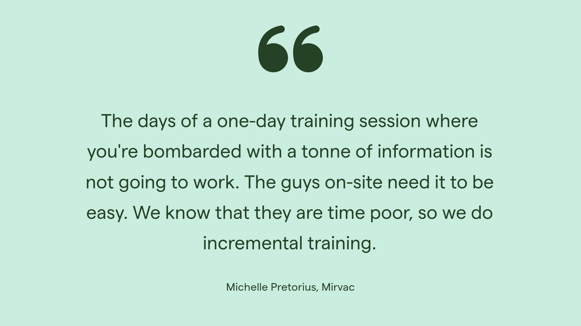The Future of Construction Summit 2024 held in Brisbane brought together industry leaders, innovators, and experts to discuss the transformative trends shaping the construction landscape. The Felix team was excited to attend as an exhibitor and be part of the conversations.

Let's recap the key lessons learned.
Embracing Digital Transformation
Data Analytics: The Backbone of Modern Construction
A recurring theme throughout the summit was the pivotal role of data analytics in modern construction. Speakers emphasised the need to move beyond traditional siloed approaches and embrace a holistic view of data across the entire project lifecycle. By integrating financial and BIM (Building Information Modeling) data, construction companies can gain valuable insights into project performance, resource allocation, and cost management.
Real-world examples showcased the tangible benefits of data-driven decision-making. For instance, tracking subcontractor utilisation of loading bays and cranes can optimise resource allocation and improve project scheduling. Similarly, monitoring waste production can enhance sustainability efforts and identify cost-saving opportunities.
One speaker emphasised the importance of accurate and trustworthy data, stating, "A lot of times you won't realise that...in the construction industry, we want a lot of data, we want information. But if that information is not accurate...then that data is sometimes not any good anyway, so it's about managing that data and having that truth to that data." (Dominic Martens, Icon Construction)

Building Digital Competence
Several sessions focused on building digital competence within construction teams. The integration of digital tools requires not only the adoption of new technologies but also the upskilling of the workforce. Training programs and workshops were recommended to ensure that all team members, from site workers to project managers, understand how to leverage digital tools effectively. This approach helps in maximising the benefits of digital transformation, making it a collaborative effort across the organisation.

Digital Engineering and Virtual Reality: Transforming Design and Delivery
The summit highlighted the increasing use of digital engineering and virtual reality (VR) in construction. These technologies are revolutionising the design and delivery process, enabling stakeholders to visualise projects in a more immersive and interactive way. VR simulations can be used to identify potential clashes and optimise construction sequences, leading to significant time and cost savings.
Furthermore, the integration of digital engineering with data analytics is opening up new possibilities for automation and optimisation. For example, 3D scanning technology can track project progress and automate payment claims, reducing administrative burdens and improving cash flow for subcontractors.
One speaker highlighted the importance of using technology strategically, stating:

Getting ROI
While financial ROI is important, the speakers stressed the need to consider broader metrics such as improved safety, enhanced sustainability, and increased employee satisfaction when evaluating technology investments.

The panel cautioned against simply investing in every new technology that comes along. Instead, they advocated for a measured and strategic approach that focuses on identifying the right solutions for the specific needs of the organisation.
Collaboration with technology vendors, industry partners, and other stakeholders was also emphasised as crucial for identifying the right solutions, mitigating risks, and maximising the long-term value of tech investments.
Sustainability: A Core Focus for the Future
Sustainability emerged as a central theme throughout the summit. Speakers emphasised the need for the construction industry to embrace Net Zero targets and adopt more sustainable practices.
Collaboration was identified as a key enabler of sustainability outcomes. By working together with clients, supply chains, and industry partners, construction companies can develop innovative solutions that reduce embodied carbon, optimise resource use, and minimise waste.
Another speaker highlighted the tension between speed and sustainability, noting:

Every individual and team within a construction organisation has a role to play in decarbonisation efforts. By mapping out levers that can be pulled by different functional areas and providing training and education, companies can empower employees to contribute to sustainability goals.

Furthermore, connecting with the emotional aspect of sustainability and understanding the values and motivations behind it can help individuals and organisations stay committed to long-term sustainability goals.
Co-opetition: Fostering Collaboration for Industry-Wide Benefits
Panelists agreed that the industry has historically been competitive and protective of information, but this is changing due to the increasing complexity of projects, the rise of construction technology, and the need to address shared challenges.
Collaboration can lead to significant benefits, such as improved efficiency, reduced waste, and increased innovation. The banking industry was cited as an example of successful co-opetition, where competitors have collaborated on initiatives like ATM networks and cybersecurity. In the construction industry, there have been successful examples of collaboration on technology platforms and data standards.
Developing open standards for data exchange and interoperability between different technology platforms can facilitate collaboration and reduce waste. Governments can play a role in fostering collaboration by setting clear expectations for data sharing and collaboration on public projects.
Another speaker emphasised the benefits of collaboration, stating:

Fostering Cultural Change: Attracting and Retaining Talent
The summit emphasised the need for cultural change within the construction industry to attract and retain a more diverse workforce. Speakers highlighted the importance of creating inclusive workplaces that welcome individuals from all backgrounds, including women, Gen Z, and Indigenous Australians.
Strategies for fostering cultural change include:
- Implementing policies that promote diversity and inclusion
- Providing training and mentorship programs
- Creating flexible working arrangements
- Challenging stereotypes and promoting positive perceptions of the industry
By embracing diversity and inclusion, the construction industry can tap into a wider talent pool and drive innovation. One speaker emphasised the importance of empowering individuals, stating, "We need to empower people to actually be part of the change. So if someone's asking you to do something at work, well, let's ask the why behind it. Let's get that understanding to happen and let's encourage people if they say can I do this rather than saying no, that's not your job."
Other speakers highlighted the importance of:
- Addressing the unique challenges faced by women and other underrepresented groups in the industry: "I know coming from the industry that there are a lot of challenges that women face out there, one of them being that I faced in my first year was having a bathroom." (Lucinda Shilcock, UGL)
- Providing pathways and support for career changers and new entrants: "We run a number of pathway programmes that really see people starting out their journey and in in the construction sector... how we start that programme is with our foundation skills, so we provide a lot of LLND support, so language literacy, numeracy and digital skills support. We also provide what I guess would call life skills, things about managing a weekly budget." (Jennifer Perkins, TAFE NSW)
- Creating a culture of respect and inclusion where everyone feels welcome and valued:

Case Study: Fulton Hogan's Journey Towards Sustainable Construction
The discussion featured Cameron Ginn, Environment and Quality Manager at Fulton Hogan, who presented a case study on their approach.
Fulton Hogan recognised the need to go beyond Scope 1 and 2 emissions and began by establishing a baseline for their direct and indirect emissions. However, the sheer number of subcontractors (almost 9,000) presented a significant challenge in data collection.
Fulton Hogan partnered with several companies to address this challenge. BraveGen, a digital sustainability reporting platform, streamlined the data collection process from subcontractors and suppliers. Pronamics, an expert in cost estimating, helped develop solutions for modeling Scope 3 emissions. Finally, Felix provided insights into the market and supplier behavior, aiding Fulton Hogan in understanding their supply chain better.

By integrating these solutions with their existing systems, Fulton Hogan was able to compare end-of-month reporting with data analytics processes, ERP software, and engineering documents. This allowed them to track emissions throughout the project lifecycle and identify opportunities for reduction.
For them, "this has been as much about introducing a new software platform as it has been about beginning to turn the ship around when it comes to the culture of reporting emissions."
Importantly, Fulton Hogan emphasises the importance of industry collaboration. They actively work with industry bodies like the Australian Constructors Association (ACA) to develop emissions reporting guidelines and advocate for sustainable practices.

Case Study: Mirvac’s Digital Journey
Mirvac's digital transformation journey serves as a practical example of how construction companies can harness the power of data and digital tools.
Here are the key takeaways:
- The speaker - Clive Parsons, Director, Digital Constructions at Mirvac - identified three common responses companies have to digital disruption:
- Head in the Sand: Ignoring digital advancements and clinging to traditional methods.
- Shiny Object Syndrome: Focusing on the latest technology trends without a clear strategic plan.
- Strategic Advantage: Utilising digital technologies to create a competitive edge by streamlining processes and improving data management.
- Mirvac is actively working to improve its digital maturity by:
- Centralised Data Structure: They are structuring data around two dimensions: finance and trade. This allows for easier cost tracking and association of information with specific aspects of the project.
- BIM Model Integration: All project data is linked back to the Building Information Model (BIM) for a holistic view of the project.
- Breaking Down Silos: Information is accessible across all departments, removing the siloed approach to data management.
- Mirvac highlights several benefits of their data-driven approach and the future possibilities:
- Improved Subcontractor Management: Data can be used to analyse subcontractor performance, including loading bay utilisation and waste generation. This allows for better contract negotiations and incentivises sustainable practices.
- Automated Payment Claims: Automated progress tracking through 3D scanning can eliminate disputes and delays in payment claims.
- Enhanced Decision-Making: Real-time data provides insights for better decision-making throughout the project lifecycle.
-----
And that's a wrap for this year's FCON. Did we miss anything? Tell us your FCON 24 highlights in the comments.
We hope to see you again next year for even more exciting updates.
Related Articles

Felix and Aconex: Paving the way forward through smart integrations
At the end of November, the team here at Felix celebrated an exciting milestone as we launched our first native integration between Felix and Aconex Document Management System (DMS).

Enabling Disruption in Construction
The Australian construction industry is at a turning point as the number of projects increases while productivity decreases. Experts tout the current state of inefficiency is due to the industry’s stagnant operations being unable to manage the shortages and uncertainty in its supply chain. History shows us that this state indicates an industry ready for disruption.

Greater supply chain transparency and diversity will drive construction’s sustainable future
As the Australian government attempts to deliver one of the greatest infrastructure booms in its history, there exists a prevailing and urgent threat to its impact on people and planet, including on the health and well-being of its workforce.
Let's stay in touch
Get the monthly dose of supply chain, procurement and technology insights with the Felix newsletter.



